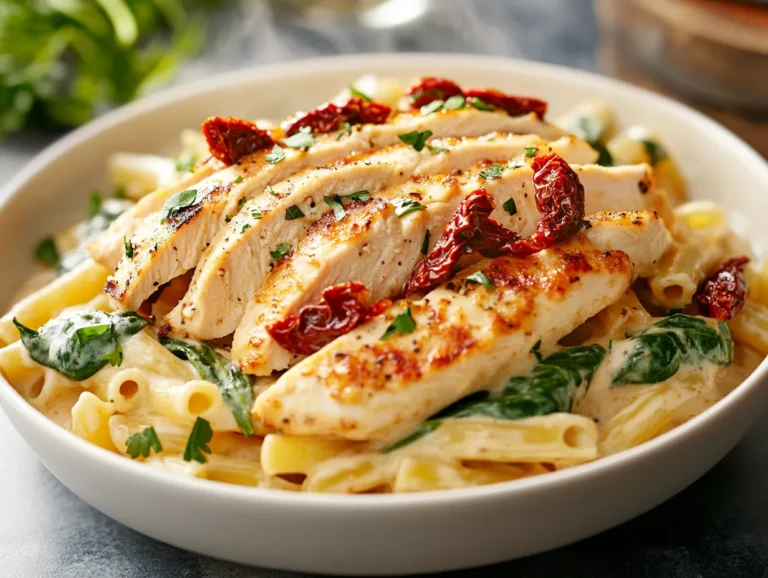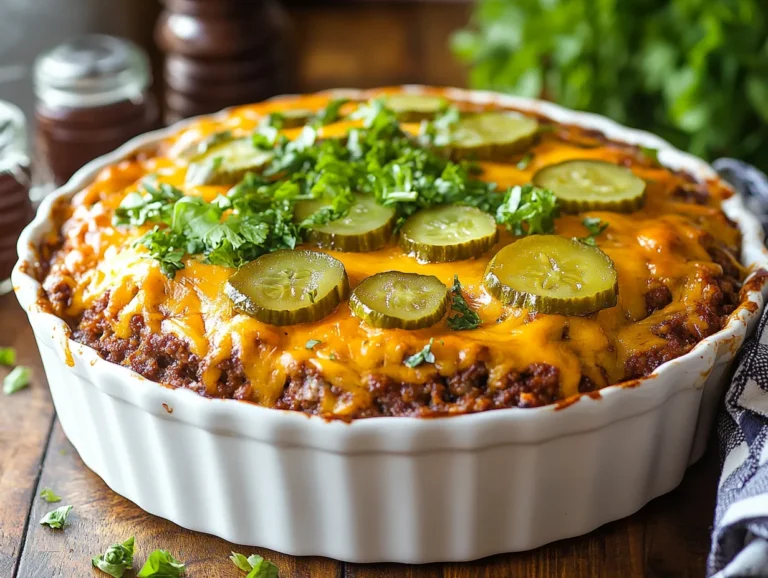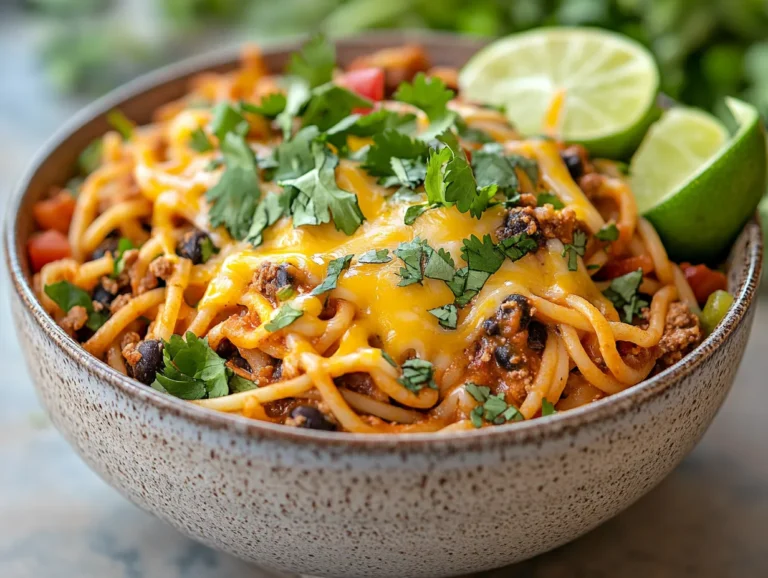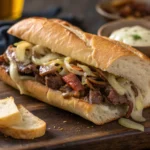If you’re craving pizza but want something lighter, healthier, and still totally satisfying — you’re in the right place. This cottage cheese pizza crust has become one of my favorite go-to recipes when I want comfort food without the carbs.
I’ve tested it multiple times in my kitchen, tweaking the texture, bake time, and toppings to get it just right. What surprised me most? How crisp and sturdy the crust turned out — all without flour, yeast, or complicated steps.
Whether you’re following a high-protein diet, watching your carbs, or just curious about using cottage cheese in a new way, this recipe is easy, fast, and full of flavor. Trust me, once you try it, you’ll start making pizza this way on repeat.
Why You’ll Love This Cottage Cheese Pizza Crust
Tastes Like the Real Thing, But Better for You
I’ve tried cauliflower, almond flour, and even zucchini crusts — but cottage cheese has truly changed the game. Its mild flavor, sturdy texture, and satisfying bite make it feel like real pizza crust, unlike most low-carb versions.
Plus, there’s no strong cottage cheese taste once it’s baked. The flavor blends right in and lets your toppings shine.
High-Protein, Low-Carb, and Naturally Gluten-Free
This crust is packed with protein thanks to the cottage cheese and egg combo. That means it’ll keep you full longer, with zero blood sugar spikes. And because there’s no traditional flour, it’s naturally gluten-free — no fancy substitutions needed.
Here’s what makes this crust a smart choice:
| Benefit | Why It Matters |
|---|---|
| High Protein | Supports satiety and muscle recovery |
| Low Carb | Great for keto and diabetic-friendly diets |
| No Yeast or Rising Time | Quick to make on any night |
| Versatile Base | Works with tons of toppings |
Looking for another high-protein base idea? Don’t miss our Cottage Cheese Flatbread Recipe — it’s perfect for wraps, toasts, or as a light side.
Perfect for Quick Meals or Meal Prep
I always keep a batch of this crust in the freezer — it reheats beautifully in the oven or air fryer. When time’s tight, I just pull one out, load it with whatever veggies and sauces I have on hand, and dinner’s done in 15 minutes.
It’s also great for prepping ahead. You can bake the crust in advance and refrigerate or freeze it flat between parchment — no more scrambling on weeknights.
Ingredients You’ll Need for Cottage Cheese Pizza Crust

Cottage Cheese – The Star of the Show
For this crust, I always use full-fat cottage cheese because it gives the best texture and holds everything together better. Low-fat versions work too, but the crust tends to be a bit softer and less crispy. I recommend using small curd if you’re blending by hand, but if you’re using a food processor, either type works just fine.
I’ve also found that blending the cottage cheese before adding it to the dough helps create a smoother texture and a more cohesive crust — especially if you’re not a fan of the curds.
Eggs – Your Natural Binder
Eggs are what make the crust hold together. They also add to the protein content and give the crust a bit of structure. I use two large eggs for every 1 cup of cottage cheese — this ratio gives you a firm, flexible base without making it too eggy.
If you’re egg-free, you could try a flax egg substitute, but be aware that it may slightly change the texture and won’t crisp up quite the same.
Curious how else you can bake with cottage cheese? Try our Cottage Cheese Bagels Recipe — a great low-carb breakfast option using similar ingredients.
Grated Cheese – For Texture and Flavor
A small handful of shredded mozzarella or parmesan adds both structure and richness to the crust. It also encourages even browning as it bakes. I like to combine the two — mozzarella for its meltability and parmesan for a bold, savory kick.
Optional Add-Ins That Boost Flavor
Once you get the base right, feel free to play with flavors. Here are a few things I’ve tried and loved:
- Garlic powder or onion powder adds a simple, savory depth to the crust’s flavor.
- Italian seasoning or dried basil for classic pizza vibes
- A pinch of salt (especially if your cottage cheese is unsalted)
Kitchen Tools & Prep Tips for the Best Cottage Cheese Pizza Crust
Tools You’ll Need (Nothing Fancy)
You don’t need anything complicated for this recipe. In my kitchen, these are the basics I always use:
- A food processor or blender works great to create a smooth, lump-free cottage cheese mixture.
- Mixing bowl and spatula
- Baking sheet or pizza pan
- Parchment paper (a must for easy release)
- Oven (air fryer works in small batches too)
If you like a super crispy bottom, use a preheated pizza stone or a cast-iron skillet — both work beautifully and give the crust a nice golden finish.
Prep Tips from My Own Kitchen
I’ve made this crust enough times to know where things can go wrong, so here are my best prep tips:
- Drain excess liquid: If your cottage cheese is watery, strain it through a fine mesh sieve before blending. Too much moisture makes the crust soft and hard to flip.
- Prebake the crust: Always bake the crust before adding toppings. This firms it up so it doesn’t get soggy.
- Use parchment paper: It makes removing the crust a breeze and prevents sticking.
- Don’t overload with toppings: Keep it light. A heavy layer of sauce or too much cheese will make the crust soggy.
How to Make Cottage Cheese Pizza Crust Step-by-Step
Making cottage cheese pizza crust is much easier than you’d expect. No yeast, no rise time, and no complicated shaping. Here’s exactly how I do it every time for the best results.
Step 1: Blend the Ingredients
Start by adding the cottage cheese, eggs, shredded cheese, and any seasonings you like into a blender or food processor. I prefer using a food processor because it gives you a smoother, thicker mixture.
Pro Tip: If your cottage cheese is extra wet, drain it through a fine mesh sieve before blending. Too much moisture will make the crust fall apart or bake unevenly.
Step 2: Spread the Mixture on a Baking Sheet
Line a baking tray or pizza pan with parchment paper and lightly spray it with oil. Pour the blended mixture onto the sheet and use a spatula to spread it evenly into a round or rectangular shape. Keep it about ¼ inch thick — not too thin, not too thick.
You want it flat enough to cook through, but thick enough to stay sturdy under toppings.

Step 3: Bake the Crust First
Bake the crust at 400°F (200°C) for 20–25 minutes until it’s golden and firm to the touch. This step is critical. Pre-baking ensures the crust holds together once you add sauce and toppings.
Once baked, the crust should lift cleanly from the parchment paper. If it’s still sticking or feels a bit too soft, let it bake for another 3 to 5 minutes.
Step 4: Add Your Toppings and Bake Again
Once the crust is pre-baked, add your favorite pizza sauce, cheese, and toppings. Pop it back into the oven for another 8–10 minutes, or until everything is melted and bubbly.
Expert Tips for the Perfect Texture

After testing this cottage cheese pizza crust in every way I could think of, here are a few key tips that make a big difference in the final texture.
Get That Crispy Edge
If you like your pizza with a crunchy bite, bake the crust a little longer during the first bake — around 28–30 minutes total, depending on your oven. You can also finish it under the broiler for 1–2 minutes after topping to crisp it even more.
A pizza stone or cast iron pan also helps develop that golden, crispy base.
Avoid the Common Mistake: Too Much Moisture
The #1 issue I’ve seen when people try this crust is too much liquid in the mix. Cottage cheese can vary a lot by brand — some are thick, others watery. If your mix looks runny after blending, stir in 1–2 tablespoons of almond flour, oat flour, or even ground flax to thicken it up naturally.
If you love protein-packed egg-based dishes, check out our Baked Cottage Cheese Eggs — another simple and satisfying low-carb bake.
Watch the Bake Time
Since oven temperatures can vary, this crust can shift from underdone to overly crisp quickly. I recommend checking it around the 20-minute mark — once the edges turn golden and the center lifts easily from the parchment, it’s good to go.
Topping Ideas That Pair Well with Cottage Cheese Pizza Crust
One thing I love about this cottage cheese pizza crust is how versatile it is. Since the flavor is neutral and savory, you can go classic, bold, or light — and it still holds up beautifully.
Here are my go-to topping combos that always turn out great:
Veggie Combos That Just Work

If you want a plant-based pizza that doesn’t taste like you’re sacrificing flavor, try these combinations:
- Spinach + Mushrooms + Mozzarella: Classic and earthy
- Roasted Red Peppers + Onions + Zucchini: Light and full of color
- Cherry Tomatoes + Basil + Vegan Mozzarella: Like a Margherita with a twist
For best results, I always pre-cook watery vegetables like zucchini or mushrooms to prevent them from releasing moisture onto the crust.
High-Protein Toppings Without Meat
Keeping things meat-free? You can still pack on the protein:
- Egg + Arugula + Goat Cheese (bake the egg right on top)
- Tofu Crumbles + Bell Peppers + Mozzarella
- Ricotta Dollops + Spinach + Chili Flakes
These combos work great when you want to stay full and energized without adding meat.
Flavor Combos with a Healthy Twist
I’m all for creative toppings, but balance is key. Here are a few more ideas I’ve tested:
- Pesto + Roasted Broccoli + Shaved Parmesan
- Hummus Base + Cucumber Ribbons + Crushed Red Pepper (after baking)
- Caramelized Onion + Feta + Fresh Thyme
Storage, Reheating, and Freezing Tips
This cottage cheese pizza crust is surprisingly freezer-friendly and stores well, which is a huge win for meal prep or leftovers.
How to Store Leftovers
After the pizza has cooled completely, I store leftovers in an airtight container or wrap slices individually. You can refrigerate them for up to 4 days.
If you plan to stack slices, add parchment or wax paper between them to keep them from sticking together.
Best Way to Reheat (No Soggy Crusts)
I always reheat this crust in the oven or air fryer — never the microwave. Here’s how I do it:
- Oven: 375°F for 5–7 minutes
- Air Fryer: 350°F for 3–4 minutes
This keeps the crust crisp and avoids the rubbery texture you often get from microwaving.
Freezing for Later
You can freeze the pre-baked crust or the fully topped, cooked pizza. I recommend baking the crust first, letting it cool, and then freezing it flat between parchment paper.
When you’re ready to use it, just pull it from the freezer, add your toppings, and bake straight from frozen at 400°F for 10–12 minutes.
Nutritional Info & Dietary Fit for Cottage Cheese Pizza Crust
If you’re like me, you probably want to know exactly what’s going into your meals — especially when you’re aiming for high-protein or low-carb goals. That’s why I broke this cottage cheese pizza crust down based on my most commonly used ingredient ratios.
Calorie Breakdown & Macros (Per Serving)
Here’s a rough estimate for one serving (¼ of a full crust), depending on brand and specific ingredients:
| Nutrient | Per Serving (¼ Crust) |
|---|---|
| Calories | 180–220 kcal |
| Protein | 16–20g |
| Carbs | 3–5g |
| Fat | 10–12g |
| Fiber | <1g |
These numbers are for the crust only, not including sauce or toppings. That makes it a solid base for building a balanced, nutrient-dense pizza without blowing your macros.
Want to make your own cottage cheese at home? Learn step-by-step in our Homemade Cottage Cheese Guide.
Is Cottage Cheese Pizza Crust Keto-Friendly?
Absolutely. As long as you choose a low-carb marinara and skip sugary sauces, this crust works perfectly for keto or low-carb meal plans. The high protein and fat content help keep you full while keeping carbs low.
Can You Make It Dairy-Free or Vegan?
Technically, yes — but not without a few changes. If you’re dairy-free, you’ll need a plant-based cottage cheese substitute and vegan cheese. I’ve tested this with almond-based cottage cheese and found it works, but it doesn’t crisp up quite the same. Still tasty, though!
For a vegan version, swap the eggs with flax eggs or a commercial egg replacer. Just know that the crust may be softer and need extra bake time.
Common Questions About Cottage Cheese Pizza Crust
Over time, I’ve received a lot of questions about this recipe — especially from people trying it for the first time. Here are some quick, clear answers to help you out:
Can You Make Cottage Cheese Pizza Crust Without Eggs?
Yes, but expect a softer crust. Eggs help bind everything and give structure. If you need an egg-free option, try two flax eggs (2 tbsp flaxseed + 5 tbsp water, mixed and rested for 5–10 minutes). You may also need to bake a bit longer to firm up the texture.
Is This Crust Gluten-Free?
Yes, the base recipe contains zero flour and no gluten-containing ingredients. Just double-check your shredded cheese and any seasoning blends — some can sneak in additives with gluten.
Can I Use Low-Fat or Fat-Free Cottage Cheese?
You can, but I personally don’t recommend fat-free. It tends to make the crust watery and less crispy. Low-fat works better, but full-fat cottage cheese gives the best balance of structure, flavor, and browning.
Cottage Cheese Pizza Crust Questions Answered
Can I make cottage cheese pizza crust without flour?
Yes! This recipe is completely flourless. The combination of cottage cheese, eggs, and shredded cheese creates a stable, firm crust on its own — no flour or binding agents required. If your batter is too wet, you can add 1–2 tablespoons of almond or oat flour, but it’s totally optional.
Is cottage cheese crust suitable for keto diets?
Absolutely. This crust is naturally low in carbohydrates and high in protein and fat, which makes it perfect for keto and low-carb diets. Just be mindful of the toppings and sauce you use — avoid added sugars to stay keto-friendly.
Does cottage cheese make the crust soggy?
Not if it’s prepped correctly. To avoid sogginess, drain any excess liquid from the cottage cheese before blending. Also, always pre-bake the crust before adding toppings. These two steps make a huge difference in texture.
How long does cottage cheese pizza crust last in the fridge?
Once baked, the crust lasts up to 4 days in the fridge. Just store it in an airtight container or wrap it in foil. To reheat, pop it in the oven or air fryer to keep the crisp.
What kind of cottage cheese is best for baking?
I always recommend full-fat, small-curd cottage cheese. It’s thicker, less watery, and blends better, creating a firmer and more cohesive crust. If you’re using a low-fat version, be sure to drain it first.
Can I use Greek yogurt instead of cottage cheese?
Technically yes, but it won’t yield the same results. Greek yogurt is thinner and more acidic, which can lead to a wetter, less stable crust. If you’re experimenting, start by straining the yogurt and reducing the quantity slightly.
Conclusion: Why Cottage Cheese Pizza Crust Deserves a Spot in Your Meal Plan
If you’re looking for a delicious, protein-packed, low-carb alternative to traditional pizza dough, this cottage cheese pizza crust checks every box. It’s easy to make, versatile with toppings, and works for almost every diet — from keto to gluten-free.
I’ve made it more times than I can count, and it’s still one of my favorite weeknight dinners. It satisfies those pizza cravings without wrecking your goals, and it stores and reheats beautifully.
Give it a try this week — and let me know how you top yours!

Cottage Cheese Pizza Crust
Ingredients
Equipment
Method
- Preheat oven to 400°F (200°C). Line a baking tray with parchment paper.
- Add cottage cheese, eggs, shredded cheese, and seasonings to a blender or food processor. Blend until smooth.
- Pour the mixture onto the tray and spread into a round or rectangular shape, about ¼ inch thick.
- Bake for 20–25 minutes, or until edges are golden and center is firm.
- Remove from oven, add sauce and toppings, and return to oven for 8–10 more minutes.
- Slice and serve warm. Store leftovers in the fridge for up to 4 days.
Notes
– Use parchment paper to prevent sticking.
– Can be frozen after baking and reheated in the oven or air fryer.
– Low-fat cottage cheese works, but full-fat gives best texture.
– Great with veggie toppings or pesto.










